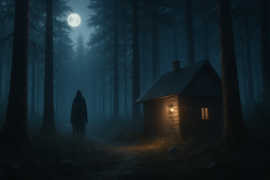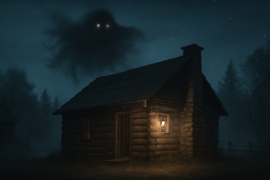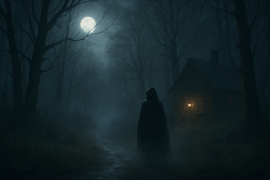Introduction
By the edge of a forgotten clearing in an old American pine forest, the air trembles with stories of a being called Char-Man Owhay. Moonlight drapes the skeletal branches in a silver sheen, and the mist coils at the feet of ancient pines, hinting at shapes unseen by daylight. Villagers who dared approach spoke of a flicker between trees—a cloak darker than the night itself—stirred by an impossible silence. Some claimed they heard him call their names, thin voices riding the wind with a hollow echo that made hearts pound in chests. From the earliest journals of frontier settlers to weathered wood carvings in mountain hamlets, the name Char-Man Owhay invoked both terror and awe. In some versions, he emerged as a punisher of trespassers, a phantom who stole torches and extinguished campfires until travelers lost their way in the black forest. In others, he appeared as a waywarden, guiding the stumbling and shyly pointing toward safety with gentle gestures. It is within these contradictions—vengeful spirit and solemn protector—that the legend grows, embodying a collective impulse to explain the unknown and justify both fear and hope. This tale immerses you in the tale’s shifting hues, exploring how whispers in pine boughs and lantern-lit doorsteps became chapters in an evolving American myth.
Whispers in the Pines
Long before roads carved through the wilderness, back when homesteads were scattered lantern lights in pitch darkness, the forest itself seemed alive with whispered warnings. Hunters returning from dusk hunts swore they heard voices floating on the breeze, syllables curling around pine trunks like living vines. The name Char-Man Owhay first surfaced in fragmented diaries—accounts of a figure dressed in ragged cloak, tall and gaunt, who watched from the trees without making a sound. A settler in early Michigan wrote of a time his pack mule bolted and lay trembling after glimpsing what he described as “a man made of charcoal standing where no fire could reach.” Farmhands spoke of tools inexplicably displaced in fields, only to find them neatly arranged at dawn by footprints leading deeper into the wood. Some believed it was a prank of restless spirits; others felt the pulse of something far older, a guardian of the land itself lurking in shadows. Folklore spread quickly by lantern light in village taverns, each storyteller embellishing the story with a personal touch—one claimed he heard Char-Man Owhay whisper encouragement when lost, another that his breath carried the scent of scorched pine and winter night. Regardless of the variations, the earliest portrayal was unmistakable: startling, elusive, and powerful in its silence.

Tales of Terror and Hope
As settlements grew around the edges of the wood, stories hardened into warnings. In New England, travelers recounted how Char-Man Owhay would extinguish their lanterns just as they approached rivers or ravines, forcing them out of their carts and onto uncertain footing. Some nights, women tending hearth fires felt a chill pass through wooden walls, and clay cups rattled as if an unseen hand tapped a pattern on their door. The specter’s eyes, when glimpsed, shone like embers, sending unsuspecting souls into breathless flight beneath the branches. Villagers kept stakes and sharpened wood at hand, believing that the phantom’s hunger for kindling and torchlight might be sated by offerings left beneath a pine bough. Yet there was a countercurrent of tales that softened his reputation. In Appalachian hollows, elders spoke of a gentle rustle in moonlit fields whenever a child wandered too close to the riverbank. A frantic mother would waken to find her lost toddler cradled safely at home, footprints leading from the water’s edge, and a cloak-shaped depression in the grass. At mountain inns, late arrivals gaped at extra firewood neatly stacked at their campsites, though no living soul had passed that way. These mixed accounts spread further than fear alone could travel: they hinted at a purpose beyond malice. Pilgrims bound west reported sense of calm descending when they felt unseen hands guiding their wagons onto safe trails. Char-Man Owhay evolved in the telling, from a robber of light to a shadowy sentinel who punished and rewarded in equal measure. Such contradictions persisted from cabin to cabin, forging a legend both terrifying and oddly comforting.

From Phantom to Protector
By the late 19th century, the tale of Char-Man Owhay had shifted again—this time toward a figure of redemption. Newspapers recounted how train conductors spotted a lanky silhouette pacing along deserted tracks, stepping aside only when a whistle cut through the night. Passengers who peered from window shutters described a bowed figure lifting lanterns from broken lamps, illuminating track switches until engineers could change course and avert disaster. Legends grew of an old miner in Colorado who credited the spirit with saving his life during a stampede of loose ore: he had run blindly down a shaft until a dark hand guided him to a hidden exit, leaving his betrayer to the collapse. In ghost story gatherings, families spoke of letters they received in block script, sealed by oil lamps and asking only for a moment of respect for nature’s edge. In return, livestock were spared from drowning in summer floods and families kept safe through blizzards. The ominous hush that once heralded terror became a calm prelude to rescue. Folklorists began to record oral histories that recast Char-Man Owhay as a custodian of travelers and pioneers, a shadow that tested human resolve only to extend a saving hand. As America embraced the mythos of frontier heroism, this redeemer spirit resonated with a collective desire for mercy amid hardship. Paintings from that era show him stepping down from knotted pine stumps, lantern in hand, his cloak draped like a mother’s shawl folded around lost souls.

Conclusion
The legend of Char-Man Owhay endures as a tapestry woven from fear and compassion, shadowed branches and guiding lantern light. From the earliest settlers who trembled at his whisper to modern storytellers who embrace his protective aura, each generation reshapes the phantom to fit its hopes and anxieties. In one village, elders still hang pine wreaths at crossroads as a token of gratitude; in another, children leave scraps of fabric on tree boughs to invoke mercy on stormy nights. Folklorists debate whether the figure sprang from a Native American watcher spirit, a misremembered trapper’s ghost, or the restless essence of the forest itself. Yet at its core, the story speaks to a universal yearning: for guidance through darkness, for justice tempered by kindness, and for the conviction that even the most fearsome shadow might conceal a helping hand. As you stand on the threshold of this tale, ask yourself which Char-Man Owhay you believe in—punisher of light or keeper of lost souls—and remember that folklore adapts to reflect our own contradictory origins and enduring redemption arcs. Char-Man Owhay invites us to confront our fears, to listen to the whispers in the pines, and to leave a lantern lit for strangers in the night, trusting that legends can both warn and save us in turn, depending on the light we bring to them. In the end, his contradictory origins become our shared tale of transformation, teaching us that darkness and hope can walk hand in hand beneath the canopy of memory and myth, guiding every wanderer home with a flicker of faith that tomorrow’s dawn will honor the past’s whispered promises and the future’s cautious embrace. Whether phantom or guardian, Char-Man Owhay remains bound to our imagination, a testament to the power of stories to change shape, and to offer redemption in the heart of the woods and beyond. Let every shadowed path you travel carry a lantern of kindness, and every whisper in the night echo with the possibility that even a phantom can become a friend beyond the pines, for tales endure as long as we believe in their contradictions, and find hope amid their deepest fears.


















